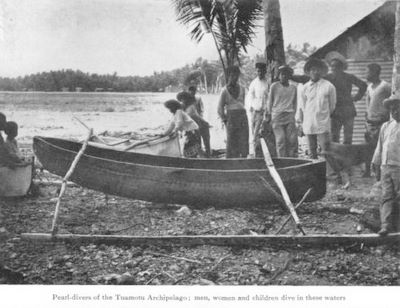|
Pearl Diving DangersDiving Dangers....scary things can happen down in the deeps.  Pearl Divers Taumuto This information is from the early twentieth century....diving suits have improved greatly since then, but enjoy these historical accounts and insights. Diving-suits or scaphanders, have been used at most of the South Sea Islands, but in a very irregular manner. They can also contribute to diving dangers. In 1890 the use of scaphanders was restricted by the Tuamotu group, and by decree of December 28, 1892, it was interdicted altogether with a view to preserving the industry to the natives, as it represents their principal means of livelihood. The suit commonly employed at Penrhyn consists of a helmet and a jumper, neither boots nor trousers being worn. Owing the absence of weights to the feet, it rarely but nevertheless sometimes happens that a diver turns upside down, and the unwieldy helmet keep him head downward while the air rushes out under the bottom cord of the jumper and he is suffocated. Also when a good patch of shells has been located, the temptation to remain down too long is too great, and paralysis often results....one of the fatal diving dangers. On the whole, these diving suits have proven to give diving dangers to the very light, graceful swimmers of these southern-seas, to whom they are about as much of an impediment as was Saul’s armor to the shepherd lad who slew the giant with the simple pebble from the sling. And there are diving dangers also in nude diving, even to those who have spent a lifetime about the water. Sharks and sting-rays and devil-fish there are in abundance, and many of them know the taste of divers flesh; on the other hand many a South Sea Islander could tell of diving dangers as a fierce combat more thrilling than even those pictured by Victor Hugo. One of the chief advantages of the diving-suit is that in case a shark comes along, the diver can bide his time until the fish is ready to leave, or he can frighten it away by ejecting air bubbles from the sleeve of his suit or by other demonstrations; whereas the nude diver is obliged to seek the air without delay, and in retreat is seized by the fish who, human like, has his appetite increased by the visible retreat of the object of his desire. Not Schiller nor Edgar Allan Poe ever conjured up a diving dangers picture more ghastly than that of a Penrhyn diver caught like a rat in a trap by some huge, man-eating shark or fierce kara mauua, crouching in the cleft of the overhanging coral, under the dark gloom of a hundred feet of water, with bursting lungs and cracking eyeballs, while the threatening bulk of his terrible enemy looms dark and steady, full in the road to life and air. A minute or more has been spent in the downward journey; another minute has passed in the agonizing wait under the rock… Has he been seen?… Will the creature move away now, while there is still time to return? The diver knows to the second how much time has passed; the third minute is on its way; but one goes up quicker than one comes down, and there is still hope….Two minutes and a half; it is barely possible now, but—the sentinel of death glides forward; his cruel eyes, phosphorescent in the gloom, look right into the cleft where the wretched creature is crouching, with almost twenty seconds of life still left, but now not a shred of hope. A few more beats of the laboring pulse, a gasp from the tortured lungs a sudden rush of silvery air bubbles, and the brown limbs collapse down out of the cleft like wreaths of seaweed. The shark has his own. Diving dangers...real threats to consider. Special thanks to Kunz and Stevenson for their 1908 account of pearl divers. More about pearl diving. Dangers of pearl divers
|






